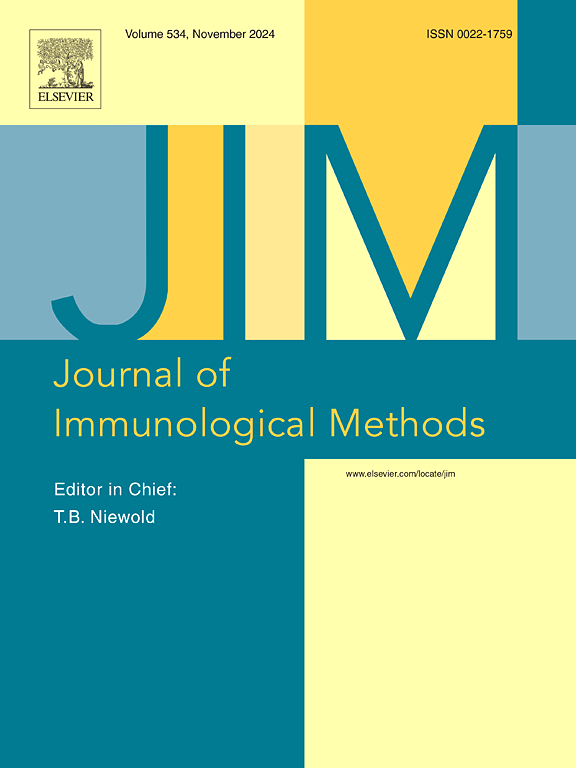流式细胞术显示,全血在TransFix®细胞稳定试剂中长期冷冻保存后,淋巴细胞比例恒定
IF 1.6
4区 医学
Q4 BIOCHEMICAL RESEARCH METHODS
引用次数: 0
摘要
流式细胞术是表征免疫细胞的一项重要技术,准确的淋巴细胞谱分析对临床诊断和研究应用至关重要。虽然立即处理血液样本是理想的,但对于大规模研究或无法立即使用实验室设施的环境,需要长期储存解决方案。TransFix®是一种化学稳定溶液,可以通过保留细胞形态和表面标记物来延迟分析。然而,长期冷冻保存对TransFix®淋巴细胞完整性的影响仍未得到充分研究。在这项研究中,我们评估了TransFix®冷冻保存对维持关键淋巴细胞亚群比例的效果,包括CD3+ T细胞、CD3+CD4+ T辅助细胞、CD3+CD8+细胞毒性T细胞、CD19+ B细胞和CD16+/CD56+自然杀伤细胞。血液样本在TransFix®中冷冻保存不同的时间,最长可达48个月,并使用流式细胞术与新鲜样本进行比较。结果表明,淋巴细胞亚群的比例在冷冻保存长达48个月的时间内保持稳定,在新鲜和冷冻保存的样本之间没有显著差异。这表明TransFix®可以成功地保持淋巴细胞的完整性以进行长期储存,为延迟分析提供可靠的选择。这些结果突出了TransFix®对于需要扩展存储的研究的有用性,使其更容易在广泛的环境中进行免疫监测。本文章由计算机程序翻译,如有差异,请以英文原文为准。
Flow cytometry reveals constant lymphocyte proportions after long-term cryopreservation of whole blood in TransFix® cell stabilization reagent
Flow cytometry is an important technique for characterization of immune cells, with accurate lymphocyte profiling being essential for clinical diagnostics and research applications. While immediate processing of blood samples is ideal, long-term storage solutions are needed for large-scale studies or settings without immediate access to laboratory facilities. TransFix® is a chemical stabilization solution that allows delayed analysis by preserving cell morphology and surface markers. However, the impact of long-term cryopreservation in TransFix® on lymphocyte integrity remains underexplored. In this study, we evaluated the efficacy of cryopreservation in TransFix® for maintaining the proportions of key lymphocyte subsets, including CD3+ T cells, CD3+CD4+ T helper cells, CD3+CD8+ cytotoxic T cells, CD19+ B cells, and CD16+/CD56+ natural killer cells. Blood samples were cryopreserved in TransFix® for varying time periods, up to 48 months, and compared to fresh samples using flow cytometry. The results show that the proportions of lymphocyte subsets remain stable during cryopreservation for up to 48 months, with no significant differences observed between fresh and cryopreserved samples. This suggests that TransFix® can successfully preserve lymphocyte integrity for long-term storage, providing a reliable option for delayed analysis. These results highlight the usefulness of TransFix® for studies that require extended storage, making it easier to conduct immune monitoring in a wide range of settings.
求助全文
通过发布文献求助,成功后即可免费获取论文全文。
去求助
来源期刊
CiteScore
4.10
自引率
0.00%
发文量
120
审稿时长
3 months
期刊介绍:
The Journal of Immunological Methods is devoted to covering techniques for: (1) Quantitating and detecting antibodies and/or antigens. (2) Purifying immunoglobulins, lymphokines and other molecules of the immune system. (3) Isolating antigens and other substances important in immunological processes. (4) Labelling antigens and antibodies. (5) Localizing antigens and/or antibodies in tissues and cells. (6) Detecting, and fractionating immunocompetent cells. (7) Assaying for cellular immunity. (8) Documenting cell-cell interactions. (9) Initiating immunity and unresponsiveness. (10) Transplanting tissues. (11) Studying items closely related to immunity such as complement, reticuloendothelial system and others. (12) Molecular techniques for studying immune cells and their receptors. (13) Imaging of the immune system. (14) Methods for production or their fragments in eukaryotic and prokaryotic cells.
In addition the journal will publish articles on novel methods for analysing the organization, structure and expression of genes for immunologically important molecules such as immunoglobulins, T cell receptors and accessory molecules involved in antigen recognition, processing and presentation. Submitted full length manuscripts should describe new methods of broad applicability to immunology and not simply the application of an established method to a particular substance - although papers describing such applications may be considered for publication as a short Technical Note. Review articles will also be published by the Journal of Immunological Methods. In general these manuscripts are by solicitation however anyone interested in submitting a review can contact the Reviews Editor and provide an outline of the proposed review.

 求助内容:
求助内容: 应助结果提醒方式:
应助结果提醒方式:


